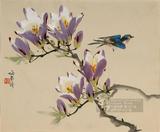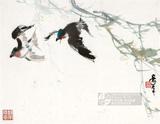明丁雲鵬畫釋迦牟尼佛 軸
推薦分享
資源連結
連結到原始資料 (您即將開啟新視窗離開本站)後設資料
- 資料識別:
- 故畫000613N000000000
- 資料類型:
- 類型:繪畫
- 型式:靜態圖像
- 著作者:
- 丁雲鵬
- 主題與關鍵字:
- 佛
- 出版者:
- 數位化執行單位:國立故宮博物院
- 格式:
- 本幅 156.8x53.1公分、全幅 63.5公分
- 關聯:
- 秘殿珠林續編(乾清宮),頁163&*故宮書畫錄(卷五),第三冊,頁454-455&*故宮書畫圖錄,第八冊,頁347-348&*1.〈明丁雲鵬畫釋迦牟尼佛〉,收入國立故宮博物院編,《晚明變形主義畫家作品展》(臺北:國立故宮博物院,1977年九月初版),頁102。 &*丁雲鵬(約西元十六世紀末期至十七世紀初期),安徽休寧人,字南羽,號聖華居士。善畫佛道人物。畫法學唐吳道子,又白描法學北宋李公麟,用筆勾勒,線細如髮絲,而眉睫間,尚能意態畢具。 本幅畫釋迦牟尼坐樹下,容貌端靜,宛若入定。通幅全用墨筆勾染,不著顏色。予人有真幻兩忘,神入華嚴淨土之感。 &*Ting Yun-p'eng was a native of Hsiu-ning, Anhwei province. His tzu (style name) was Nan-yü and his hao (sobriquet) was Sheng-hua Chü-shih. He excelled at painting Buddhist and Taoist figures, deriving his style from the T'ang master Wu Tao-tzu and his technique of outline drawing from Li Kung-lin. It is said that he drew lines so thin that they were like silken filaments and that he did not miss a single hair from the eye-lashes and eye-brows. This painting shows Śākyamuni, the historical Buddha, under a tree. His features are composed as if in a trance. Brushwork and ink consist of short, curving strokes and there is no colour. Looking at the picture, we experience the feeling that it is hard to say whether the Buddha is real or painted. We are transported into the serenity of the pure land of Hua-yen.
- 管理權:
- 國立故宮博物院
授權聯絡窗口
- 國立故宮博物院圖像授權、出版授權、影音資料授權-申請流程說明
http://www.npm.gov.tw/zh-TW/Article.aspx?sNo=03003061






